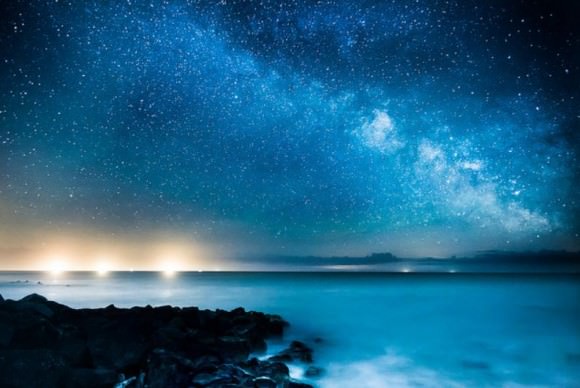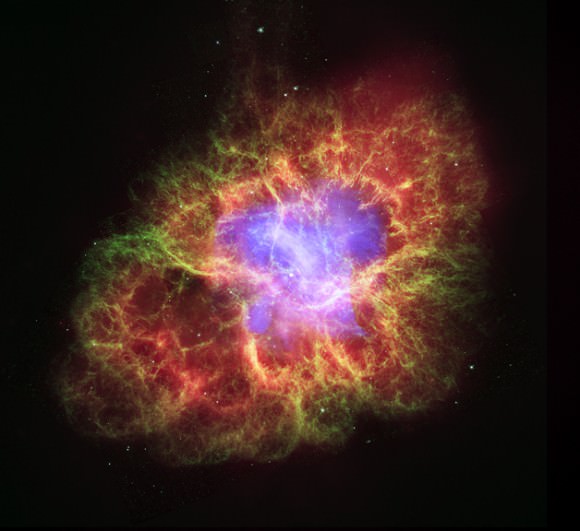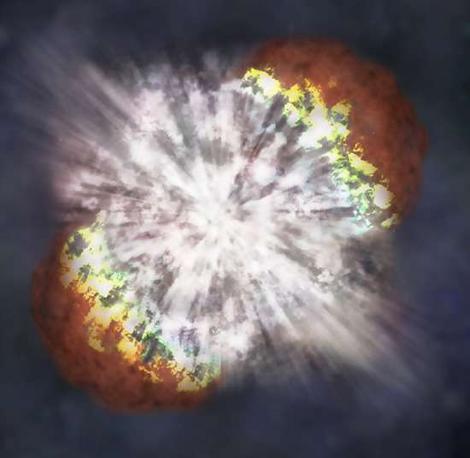An exploding star in our home galaxy might be visible to Earth in the next 50 years, astronomers say in a new calculation of the odds of a nearby supernova.
This explosion would be too faint to prove a hazard to Earthlings, and in fact it may not even be visible with the naked eye in the starry sky. Its heat signature, however, would be seen in the right kind of camera as long as we could swing a telescope there fast enough.
“For [researchers], this study suggests that they have a solid chance of doing something that’s never been done before: detect a supernova fast enough to witness what happens at the very beginning of a star’s demise,” wrote Ohio State University in a press release about the research, which was led by university astronomer researcher Scott Adams.

The challenge with observing a supernova in our own galaxy is the presence of cosmic dust that can sometimes obscure supernovae and other phenomena from our view. However, infrared light is not as badly affected by this and may be able to see something through the obscurity.
To jump on the supernova as it is happening, the scientists propose having a network in place to send out neutrino alerts when these particles, which would arrive at Earth first after an explosion, are detected on Earth. The key is to figure out the difference between neutrinos from space and neutrinos from other sources, such as nuclear reactors, the sun or even spurious glitches.
A University of Tokyo group led the building of a model of a new kind of neutrino detector, a model that is now operating underground in Japan. Called EGADS (Evaluating Gadolinium’s Action on Detector Systems), the water in the system would be “spiked” with a bit of gadolinium, which would reportedly assist with neutrino detections from outside of Earth.

“When a neutrino from a Milky Way supernova enters the tank, it can collide with the water molecules and release energy, along with some neutrons,” Ohio State added. “Gadolinium has a great affinity for neutrons, and will absorb them and then re-emit energy of its own. The result would be one detection signal followed by another a tiny fraction of a second later—a “heartbeat” signal inside the tank for each detected neutrino.”
But what about a naked-eye supernova? The researchers say the probability of that is just 20% to 50% in the next century, with southern hemisphere residents having a better chance since more of the galaxy is visible there. The last instance of this happening, by the way, was in 1604.
The research paper is available now on prepublishing site Arxiv and will soon be published in the Astrophysical Journal.
Source: Ohio State University
Correction: This article has been changed to remove a reference to Ohio State University in the EGADS collaboration.


I keep hoping for Betelgeuse to go before I do, sigh. Probably not going to happen though.
In paper they say that:
“Based on our modeled observability, we find a Galactic ccSN [core collapse SN] rate of 3.2 (+7.3/-2.6) per century and a Galactic Type Ia SN rate of 1.4 (+1.4/-0.8) per century for a total Galactic SN rate of 4.6 (+7.4/-2.7) per century is needed to account for the SNe observed over the last millennium.”
So once per 50 years would be a very conservative estimate. It was an interesting read how that number was derived, even though they took into account only 5 Galactic SNe observed since 1000 AD [3.5]. Thanks!
EDIT: But yes, that estimate takes into account all SNe (not only naked-eye ones). Still, we are way overdue.
Or, at 7500 Ly, Eta Carina
Credit: X-ray: NASA/CXC/GSFC/M.Corcoran et al.; Optical: NASA/STScI
Observation Dates: 5 pointings from Oct 2002 – Sep 2003
Release Date June 20, 2007
I would have to travel to see Eta Car. Betelgeuse is in much better position and it can be observed from most of the world.
I am With you on that. We could Call for it Three times though
Betelgeuse! Betelgeuse! Betelgeuse! …… waiting… …
naaaaaaa Nothing
What I fail to understand is that supernovae usually ‘outshine the whole galaxy they reside in’. Dust or no dust, should the glow not be visible for all to see anyway?
From what I understand, part of that depends on the type of SN. Some outshine everything else, others are (relatively speaking) much dimmer.
That’s correct. You have to take into account failed SNe. You know, failed ‘coz the star was so massive it collapsed entirely (or almost entirely) into a Black Hole! In such cases the star just disappears without any visible light signal, cool, eh?
In such cases the star just disappears without any visible light signal, cool, eh? 
Here’s a nice paper I found describing this and techniques of finding them: A SURVEY ABOUT NOTHING: MONITORING A MILLION SUPERGIANTS FOR FAILED SUPERNOVAE
That’s correct. You have to take into account failed SNe. You know, failed ‘coz the star was so massive it collapsed entirely (or almost entirely) into a Black Hole! In such cases the star just disappears without any visible light signal, cool, eh?
In such cases the star just disappears without any visible light signal, cool, eh? 
Here’s a nice paper I found describing this and techniques of finding them: A SURVEY ABOUT NOTHING: MONITORING A MILLION SUPERGIANTS FOR FAILED SUPERNOVAE
When did we get Disqus back? I’ve been skipping reading comments for a while, only hitting this site every few days.
Good to see Disqus back. Seems many former regular posters vanished after Disqus was dropped. The quality of the commenting seemed to go down and it was annoying reading about “shares”.
I imagine that Fraser noticed the same thing you and I did. And I imagine that he saw fewer hits because of it.